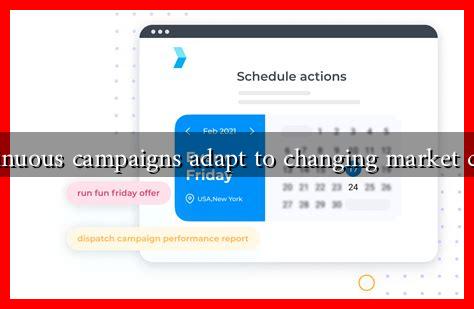-
Table of Contents
Can Continuous Campaigns Adapt to Changing Market Conditions?
In today’s fast-paced business environment, the ability to adapt to changing market conditions is crucial for the success of any marketing campaign. Continuous campaigns, which are designed to run over an extended period, often face challenges when external factors shift. This article explores how continuous campaigns can remain flexible and responsive to market changes, ensuring they continue to deliver value and achieve their objectives.
Understanding Continuous Campaigns
Continuous campaigns are marketing strategies that are executed over a prolonged period, often without a defined end date. These campaigns can include various forms of marketing, such as digital advertising, social media engagement, and content marketing. The primary goal is to maintain brand visibility and engagement with the target audience consistently.
The Importance of Adaptability
Market conditions can change due to various factors, including economic shifts, consumer behavior changes, technological advancements, and competitive dynamics. For continuous campaigns to be effective, they must be adaptable. Here are some reasons why adaptability is essential:
- Consumer Expectations: As consumer preferences evolve, brands must adjust their messaging and offerings to meet these new expectations.
- Market Trends: Staying ahead of market trends can provide a competitive advantage, allowing brands to capitalize on emerging opportunities.
- Economic Factors: Economic downturns or booms can significantly impact consumer spending, necessitating a shift in marketing strategies.
Strategies for Adapting Continuous Campaigns
To ensure that continuous campaigns can adapt to changing market conditions, marketers can implement several strategies:
- Data-Driven Decision Making: Utilizing analytics tools to monitor campaign performance and consumer behavior can provide insights that inform necessary adjustments.
- Agile Marketing Practices: Adopting agile methodologies allows teams to respond quickly to changes, enabling rapid testing and iteration of campaign elements.
- Regular Market Research: Conducting ongoing market research helps brands stay informed about shifts in consumer preferences and competitive landscapes.
- Flexible Budgeting: Allocating budgets that can be adjusted based on performance metrics allows for reallocation of resources to the most effective channels.
Case Studies of Successful Adaptation
Several brands have successfully adapted their continuous campaigns to changing market conditions, demonstrating the importance of flexibility:
- Coca-Cola: During the COVID-19 pandemic, Coca-Cola shifted its marketing focus from large events to digital engagement, emphasizing community support and health awareness. This pivot allowed them to maintain brand relevance during a challenging time.
- Netflix: As consumer viewing habits changed, Netflix continuously adapted its content marketing strategy by leveraging data analytics to recommend personalized content, ensuring user engagement remained high.
- Amazon: Amazon’s continuous campaign strategies include dynamic pricing and personalized recommendations, which adapt in real-time based on consumer behavior and market trends.
Challenges in Adapting Continuous Campaigns
While adaptability is crucial, it is not without its challenges. Some common obstacles include:
- Resource Constraints: Limited budgets and personnel can hinder a brand’s ability to pivot quickly.
- Resistance to Change: Organizational inertia can prevent teams from embracing new strategies or technologies.
- Data Overload: With the abundance of data available, identifying actionable insights can be overwhelming.
Conclusion
In conclusion, continuous campaigns can indeed adapt to changing market conditions, but it requires a proactive approach and a willingness to embrace change. By leveraging data, adopting agile practices, and staying attuned to market trends, brands can ensure their campaigns remain relevant and effective. The ability to pivot in response to external factors not only enhances campaign performance but also strengthens brand loyalty and consumer trust. As the market continues to evolve, the brands that prioritize adaptability will be the ones that thrive.
For further insights on marketing strategies and adaptability, consider exploring resources from Harvard Business Review.

